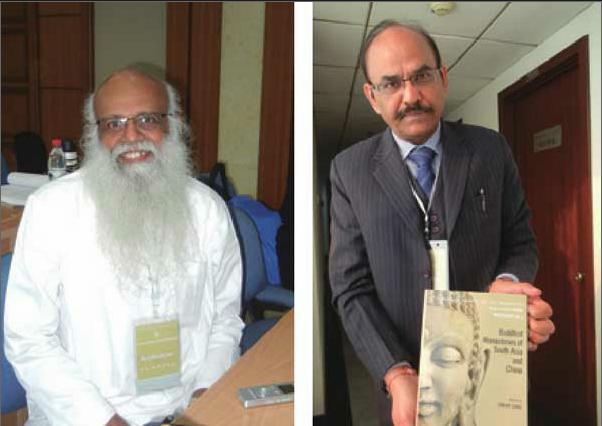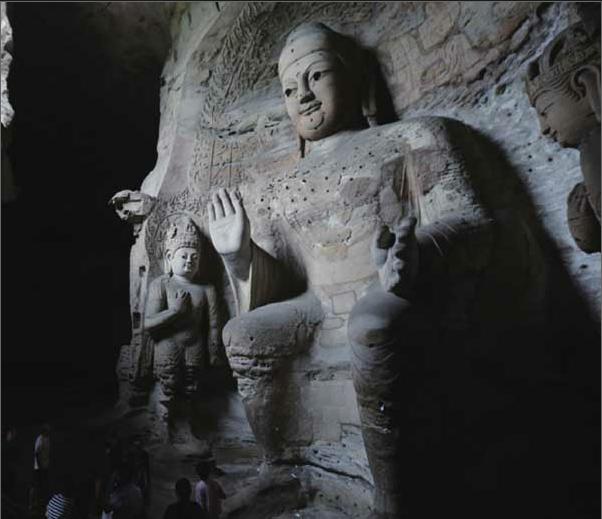The Common Thread
2016-12-26BySudeshnaSarkar
By+Sudeshna+Sarkar


Two conferences in four years changed Sanjay Gargs professional focus, making him part of a movement that is seeking to bring to light a rich heritage shared by China and South Asia.
The first was in 2010 when Garg, currently deputy director of the National Archives of India in New Delhi, went to Vienna on the occasion of the 40th anniversary of the European Association for South Asian Archaeology and Art. “It was amazing,” he said. “The entire whos who of South Asian art and archaeology were there. I asked myself, why do we have to come to European countries to discuss our art?”
It was because, he explained, there was a “total disconnect” in the exchange of information and experiences about major discoveries in post-colonial South Asia after the work of primarily British archaeologists like Alexander Cunningham, the first director of the Archaeological Survey of India(ASI) who excavated Buddhist sites in famed pilgrimage centers like Sarnath in India; John Marshall, the 19th-century ASI director general who led excavations in Harappa and Mohenjo-daro, relics of the Indus Valley Civilization; and Robert Wheeler, who conducted excavations in India and Britain.
Total disconnect
“Ask an Indian archaeologist what has been happening in Pakistan in the last 15 years and the chances are he wont know. Ask a Sri Lankan about Bhutan and you will find the same thing,” Garg said.
The thought was reinforced when he went to Dazu District in southwest Chinas Chongqing Municipality two years ago. It is a UNESCO World Heritage Site, famed for rock carvings created between the 7-13th centuries.
“I was amazed by the in-depth research going on in China that we are not aware of, principally because of the language barrier,”he said. “One common thread runs between China and South Asian countries. Thats Buddhism. So the best way [of connecting] is to build a platform where research could be exchanged.”
Other Buddhist scholars were also thinking along similar lines and in 2014, when Li Chongfeng, professor of Buddhist art and archaeology at Peking University, and Kamal Sheel, professor of Chinese studies at the Banaras Hindu University in India, proposed establishing such an organization at the 2014 International Symposium on Dazu Studies in Dazu, it was met with enthusiasm. That is how the Society for Buddhist Art and Archaeology (SBAA) was founded.
Since then, the SBAA meets alternately in China or a South Asian country every year to discuss new discoveries based on a specific theme. Last year, the inaugural conference in New Delhi was about the Buddhist monasteries in China and South Asia. This year, the SBAA together with the Institute of Archaeology at the Chinese Academy of Social Sciences (CASS) and Peking Universitys School of Archaeology and Museology, held the second conference in Beijing on November 26-27. The International Conference on Buddhist Archaeology in China and South Asia discussed Buddhist archaeology in the region, especially rock and cave archaeology and art. Pakistan has been proposed as the host country next year when the conference will be themed on Buddhist art schools of South Asia and China.
The papers presented in 2015 were released as a monograph, Buddhist Monasteries of South Asia and China, this year, and this years papers will be collected in a volume to be released at the 2017 conference.
Another face of Pakistan
Kiran Shahid Siddiqui is a little-known face of Pakistan. The 43-year-old from Karachi, Pakistans financial capital, is a postdoctoral fellow of Peking University. The subject of her research was the extension of Gandhara art into China.
Gandhara was a major Buddhist kingdom between the 1st century B.C. and the A.D. 7th century, comprising parts of Pakistan and Afghanistan. “It was an important fountainhead of Buddhist art, which spread under the patronage of the Kushan emperors,”Siddiqui said. “Gandhara art was the first to represent the Buddha in the human form, with which the worship of the icon started. Earlier, the Buddha would be depicted by symbols like the lotus, footprints or an umbrella. Gandhara art was also known as Greco- or Roman-Buddhist art because of the influence of Greek and Roman culture and spread to India as well as Central Asia and then, through the Silk Road, to China, Korea and Japan.”
Siddiqui had been examining the Buddhist grottoes in China. The three best known Chinese Buddhist caves are the Yungang Grottoes in Datong in Shanxi Province, which are the repository of more than 50,000 Buddha statues and statuettes; the Mogao Caves in Dunhuang in Gansu Province, also known as the Dunhuang Caves; and the Longmen Grottoes in Luoyang in Henan Province. She has also been to the lesser known ones like the Bezeklik Thousand Buddha Caves in Xinjiang Uygur Autonomous Region and the Binglingsi Grottoes in Lanzhou, Gansu. Her research is on finding Gandhara art influences in China.
Cultural influences
Talking about the similarities between the two made Siddiqui animated. “In Gandhara art, probably the most abundant images after the Buddha are those of Vajrapani and Heracles. Vajrapani, meaning he who wields the thunderbolt, is another name of the Hindu god of rain Indra,” she explained. “We also have the presence of other typically Hindu forms like Shiva, the god of destruction, and apsaras, celestial dancers in Hindu myths. On the other hand, Heracles is the Roman hero also known as Hercules to the Greeks and his inclusion shows Greco-Roman influence. All this indicates the Gandhara rulers were liberal, accepting influences from other cultures. Gandhara art brought some of these images to Chinas Buddhist caves, like the Shiva in Yungang and Vajrapani and Heracles, who became one in Chinese sculpture.”
The exchange has been a two-way traffic. While influencing China, Gandhara art also carried Chinese influence to Central Asia. Duan Qing with the Institute of Archaeology at CASS described the discovery of wooden tablets, which resemble Chinese administrative tablets but have inscriptions in Kharosthi, a script used in the Gandhara Kingdom, indicating the Chinese influence outside China. Some Central Asian kingdoms followed the Chinese administrative system as well, including the demarcation of provinces as administrative units. All this shows an interconnection between religions, cultures and regions, which continues even today.
“I am putting my findings together in a book,” Siddiqui said. “My book will show the positive, soft image of Pakistan that many people outside do not know. There have been extremists destroying religious legacy in Pakistan but they are very few. We are Muslim, we are very broad-minded and we give space to all religions and sects.”
While Buddhist monkscholars like Xuanzang and Faxian became famed for their dedication to bringing Buddhist texts to China and having them translated into Chinese, there are many other unsung initiators who too acted as a link between China and the outside world, contributing to the creation of a common cultural heritage.
Kashmir legacy
Zhang Changhong with the Palace Museum in Beijing highlights the work of Bzang Po, a monk and translator who lived between 958 and 1055. Born in Guge in western Tibet, southwest China, he went to India to study Buddhism and Sanskrit, residing in Kashmir and beyond. When he came back, he was accompanied by scholars and artists from Kashmir, who helped to translate Buddhist scripts and painted murals for monasteries and Buddhist shrines in Tibet.
Zhang has co-authored a paper on the three different periods of Buddhist cave frescoes in Tibet, with Huo Wei with the School of History and Culture at Sichuan University, detailing cultural influences from abroad.
“In the past decades, a lot of Buddhist caves with exquisite frescoes were found in Ngari Prefecture, Tibet Autonomous Region, which witnessed the revival and flourish of Buddhism in the remote western Tibetan area toward the end of the 10th century to the 17th century. The discovery of these caves not only provides important materials for the study of Tibetan Buddhist art history, but also reflects different cultural influences from different neighboring areas,” the paper says.
From the 13-14th century, another country influenced Buddhist art in China—its southern neighbor Nepal, the birthplace of the Buddha. According to the two scholars, the period came to be known as the“international style” period due to the prevalence of the Nepali style in Tibetan culture.
Is Buddhist art relevant?
In an era preoccupied with global warming, the economic crisis and the rise of extremist organizations, is Buddhist art still relevant, especially in China, given Chinas identity as a communist country?
The answer was an unequivocal yes from scholars though the reasons given were diverse. “Cultural exchanges between China and the rest of the world never stopped,”Zhang said. “No matter who ruled, the Han Dynasty (202 B.C.-A.D. 220), the Tang Dynasty (618-907) or the Yuan Dynasty(1271-1368), the exchanges continued.”She referred to an ongoing exhibition at the Palace Museum in Beijing displaying Indian sculptures, Across the Silk Road: Gupta Sculptures and Their Chinese Counterparts Between A.D. 400 and 700. “It shows that the cultural connection between India and China continues,” she emphasized.
Garg from the National Archives of India called it part of world cultural heritage which nurtures modern concepts like tourism and the economy. “Tourism cant be disconnected from cultural heritage,” he said. “Buddhist art is a part of our intangible cultural heritage and that is why it should be protected through preservation and more research.”
Sri Lankan author Daya Dissanayake, who raises a question about the Buddhas existence in his e-novel Clone, differentiated culture from religion, saying it could reconcile everything. Besides, Buddhist art was not about Buddha the man but the dharma—the tenet—that the Buddha preached, which was nonviolence and amity toward all.
“It is not important who preached or propagated it,” Dissanayake said. “We need only what Buddhism preaches. And that has been said in four words by Ajahn Buddhadasa(an influential Thai monk who lived between 1906-1993): Be peaceful and useful.”
